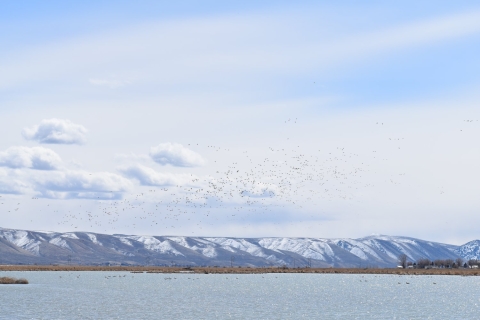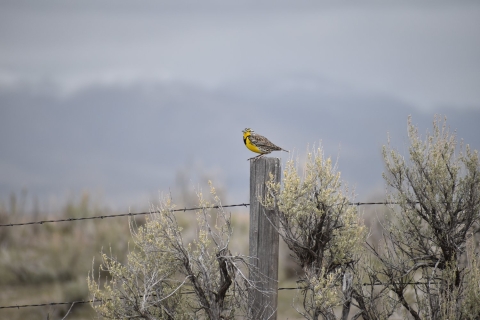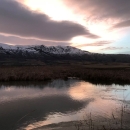Visit Us
National wildlife refuges offer us all a chance to unplug from the stresses of daily life and reconnect with our natural surroundings. The refuge is place where you can enjoy the sights and sounds of the tens of thousands of birds that use the refuge as a migratory stop over point or vital nesting location.
Bear Lake National Wildlife Refuge, which was established in 1968, is located within Bear Lake County, near the community of Montpelier, Idaho. The 18,169-acre Refuge lies in Bear Lake Valley at an elevation of 5,925 feet and occupies a portion of the historic Dingle Swamp along the Bear River and north of Bear Lake (Map 1). The Refuge is surrounded by mountains, most notably the 6,800-foot rocky slope of Merkley Mountain to the east. Bear Lake NWR is managed by the U.S. Fish and Wildlife Service (Service) for the protection of Dingle Swamp and to provide resting and feeding habitat for migrating waterfowl. The Refuge is composed of a 16,000-acre emergent marsh, 500 acres of wet meadows, 1,250 acres of uplands, and 5 miles of riparian riparian
Definition of riparian habitat or riparian areas.
Learn more about riparian corridor. Approximately 100 species of migratory birds nest at Bear Lake NWR, including large concentrations of colonial waterbirds. Other species of non-migratory wildlife use the Refuge throughout the year. Bear Lake NWR has been designated as a Globally Important Bird Area by the National Audubon Society based on its contributions to colonial nesting waterbird habitat.
Historically the Shoshone, Ute, and Bannock tribes used the Bear Lake Valley as an important hunting ground and often camped in the area. The first Euro-American settlers to inhabit the Bear Lake Valley were members of the Church of Jesus Christ of Latter Day Saints, who arrived in 1864.
They established farming and ranching operations nourished by the waters of the Bear River. Today agriculture, along with tourism, still fuels the local economy; there are a number small cattle ranches and farms that produce barley, alfalfa, and wild hay. Water diversion from the Bear River to produce meadow hay likely occurred on a small scale during the late 1800s; however, it was in the early 1900s that substantial modification to the river system began. In 1911 the Telluride Power Company completed its diversion of water from the Bear River into Bear Lake, where a significant portion of flow could be stored for future irrigation needs. This single event greatly altered the hydrology and natural processes of the historic Dingle Swamp and Mud Lake system.
Driving Directions
From Paris, Idaho go 3 miles east on the Paris-Dingle Bottoms road, then turn south on to the refuge access road after crossing the canal bridge. From Montpelier take HWY 89 west to Airport Rd. Then take the Airport road south for 5 miles until you come to a T in road. Then jog right on the refuge public access road.
Fees
There is no charge to visit.
Restrooms
Public restrooms are available on the west side of the Salt Meadow auto tour route.
Points of Interest
Please visit our kiosks and interpretive signs along our auto tour routes and walking trails. Obtain brochures at the entrance or at various kiosks around the refuge.
What to do...
If you have 15-minutes.
Bird watching along the auto tour route.
If you have one hour.
Hike some of the trails in the Refuge.
If you have half a day or more.
Take the canoe trail, spend time doing wildlife photography, fishing, or hunting.
Tips for Visitors
Please bring plenty of drinking water and snacks. Sunscreen and insect repellant maybe needed to protect yourself from some of natures elements. Dress appropriately for the weather as the refuge is located at 5925 feet in elevation and conditions can change rapidly. Birdwatching is best during morning hours.
Activities
The refuge provides a variety of outdoor recreation activities.
Other Facilities in the Complex
Oxford Slough Waterfowl Production Area which is managed by the staff at the Bear Lake National Wildlife Refuge, is situated in the Cache Valley and is the drainage for Oxford and Deep Creeks as well as other smaller streams that cascade down from the surrounding mountains. The Oxford Slough WPA was established in 1985 to preserve an important wetland for waterfowl production. WPA lands are purchased with funds generated by the sale of Federal Duck Stamps, and managed by the Service to establish and protect waterfowl breeding and nesting habitats. Oxford Slough WPA is one of nearly 7,000 WPAs nationwide, and the only WPA in Region 1. The 1,878-acre WPA is located 10 miles north of Preston, Idaho, abutting the small town of Oxford, where it provides valuable foraging habitat for species such as cranes, geese, Franklin’s gulls, and white-faced ibis, and nesting habitat not only for waterfowl, but white-faced ibis, Franklin’s gulls, and other waterbirds. Oxford Slough WPA has been designated as a Globally Important Bird Area by the National Audubon Society based on its contributions to colonial nesting waterbird habitat.
The Refuge also manages the 1,015-acre Thomas Fork Unit, located 20 miles to the east of the Refuge on the Idaho/Wyoming border. The Unit's eastern boundary is the Wyoming State line. The Unit provides breeding habitat for greater sandhill cranes and high quality stream habitat for Bonneville cutthroat trout.
The Refuge is also the home for Idaho portion of the Bear River Watershed Conservation Area. This program works to protect farm and ranch land that has high wildlife conservation through the voluntary purchase of conservation easements on private land in the Bear River watershed.
Rules and Policies
- Drive only on designated roads, not in refuge farm fields.
- Camping, open fires, and fireworks are prohibited.
- Seasonal hunting opportunities are offered and require appropriate State and Federal permits. Please check with Bear Lake NWR for details. Approved nontoxic shot is required for waterfowl and upland bird hunting. (208-847-1757)
- No horses, all terrain vehicles, motorcycles, or dirt bikes are allowed on the refuge.
- Disturbing or collecting any plant or animal is prohibited.
- Looking for and/or collecting artifacts is not allowed.
- Pets are allowed on the refuge, but must be kept on a leash or under control of the owner at all times.
- Individuals may possess, carry and transport concealed, loaded and operable firearms on the refuge in accordance with all provisions of state and local law. Persons may only use (discharge) firearms in accordance with refuge regulations (50 CFR 27.42 and specific regulations in 50 CFR Part 32). Target shooting and sighting-in weapons is not permitted.
- Take all litter with you.
Locations






















